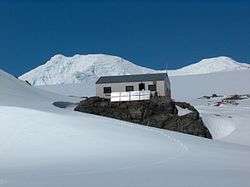St. Kliment Ohridski Base

St. Kliment Ohridski Base (Bulgarian: База Св. Климент Охридски, Baza Sv. Kliment Ohridski \'ba-za sve-'ti 'kli-ment 'o-hrid-ski\) is a Bulgarian Antarctic base on Livingston Island in the South Shetland Islands.
The base, originally known as Sofia University Refuge or Hemus Base,[1] was named in 1993 for Clement of Ohrid, a ninth- and tenth-century Bulgarian scholar and saint.[2]
Location





The base is located at 62°38′29″S 60°21′53″W / 62.64139°S 60.36472°WCoordinates: 62°38′29″S 60°21′53″W / 62.64139°S 60.36472°W, which is at an elevation of 12 to 15 m on Bulgarian Beach, 130 m inland from the shore of Emona Anchorage, between Pesyakov Hill and Sinemorets Hill, overlooking the Grand Lagoon. The base area is crossed by the melt-water Rezovski Creek in the summer, providing a water supply.
History
Following an unsuccessful landing attempt at Cape Vostok on the northwestern extremity of Alexander Island, two prefabricated huts — the Lame Dog Hut and Russian Hut — were assembled on Livingston Island between 26 and 28 April 1988 by a four-member Bulgarian party supported logistically by the Soviet Research Ship Mikhail Somov under Captain Feliks Pesyakov. The facilities were later refurbished and inaugurated as a permanent base on 11 December 1993.[1]
An expansion programme at St. Kliment Ohridski including the construction of a new multi-purpose building was carried out between 1996 and 1998 and subsequently. The St. Ivan Rilski Chapel built in 2003 is the first Eastern Orthodox edifice in Antarctica and the southernmost Eastern Orthodox building of worship in the world. A post office of the Bulgarian Posts has been in operation at St. Kliment Ohridski since 1994/1995. The base is visited regularly by representatives of the institutions responsible for Bulgaria's activities in Antarctica, including President Georgi Parvanov of Bulgaria during January 2005.[1]
Use
Personnel and cargo from supply ships are offloaded by Zodiac boats at the southwestern extremity of the beach, 300 m away from the main base facilities. A designated helipad site is located on the northern side of the Grand Lagoon.
St. Kliment Ohridski enjoys the exceptional advantage of several convenient overland routes leading from Bulgarian Beach to a variety of internal and coastal areas of Livingston Island including the Balkan Snowfield, Burdick Ridge and Pliska Ridge, Tangra Mountains and the glaciers Perunika, Huntress, Huron and Kaliakra, and Saedinenie Snowfield. The Spanish base Juan Carlos I is situated 2.7 km to the south-southwest, and is reached either by sea or by a 5.5 km route, while the central location of Camp Academia site is 11 km due east in the Tangra Mountains.
The base is used by scientists from Bulgaria and other nations for research in the field of geology, biology, glaciology, topography and geographic information. St. Kliment Ohridski is visited by cruise ships from Hannah Point, one of the most popular tourist destinations in Antarctica situated but 12 km to the west. Lame Dog Hut, the 1988 principal building of the base (the oldest on the island since the renovation of the Spanish base started in 2009) hosts the Livingston Island Museum, a branch of the National Museum of History in Sofia since October 2012.[3] The hut and its associated artefacts are considered part of the cultural and historic heritage of the island and Antarctica, designated a Historic Site or Monument of Antarctica.[4][5][6]
See also
- Lame Dog Hut
- St. Ivan Rilski Chapel
- Bulgarian Antarctic Institute
- Camp Academia
- Livingston Island
- South Shetland Islands
- Antarctica
- Antarctic Place-names Commission
- Tangra 2004/05 Expedition
Maps

- Isla Livingston: Península Hurd. Mapa topográfico de escala 1:25 000. Madrid: Servicio Geográfico del Ejército, 1991.
- L.L. Ivanov. St. Kliment Ohridski Base, Livingston Island. Scale 1:1000 topographic map. Sofia: Antarctic Place-names Commission of Bulgaria, 1996. (The first Bulgarian Antarctic topographic map, in Bulgarian)
- L.L. Ivanov et al. Antarctica: Livingston Island and Greenwich Island, South Shetland Islands (from English Strait to Morton Strait, with illustrations and ice-cover distribution). Scale 1:100000 topographic map. Sofia: Antarctic Place-names Commission of Bulgaria, 2005.
- L.L. Ivanov. Antarctica: Livingston Island and Greenwich, Robert, Snow and Smith Islands. Scale 1:120000 topographic map. Troyan: Manfred Wörner Foundation, 2010. ISBN 978-954-92032-9-5 (First edition 2009. ISBN 978-954-92032-6-4)
- Antarctic Digital Database (ADD). Scale 1:250000 topographic map of Antarctica. Scientific Committee on Antarctic Research (SCAR), 1993–2016.
Notes
- 1 2 3 Ivanov, L. General Geography and History of Livingston Island. In: Bulgarian Antarctic Research: A Synthesis. Eds. C. Pimpirev and N. Chipev. Sofia: St. Kliment Ohridski University Press, 2015. pp. 17-28. ISBN 978-954-07-3939-7
- ↑ St. Kliment Ohridski Base. SCAR Composite Antarctic Gazetteer.
- ↑ Certificate of the Livingston Island Museum. National Museum of History, Sofia, October 2012.
- ↑ ATCM Measure V (2015). Annex: Revised List of Historic Sites and Monuments. ATCM Sofia, 1–10 June 2015. pp. 21–42.
- ↑ Proposal to add the Lame Dog Hut at the Bulgarian base St. Kliment Ohridski on Livingston Island to the List of Historic Sites and Monuments. Working Paper CEP WP017. ATCM Sofia, 1–10 June 2015.
- ↑ Bulgaria successfully completed the Chairmanship of the XXXVIII Antarctic Treaty Consultative Meeting. Ministry of Foreign Affairs of Bulgaria website, 10 June 2015.
External links
- Antarctic Place-names Commission of Bulgaria
- Bulgarian Antarctic Institute
- (Spanish) Spanish Antarctic Base Juan Carlos I
- COMNAP Antarctic Facilities (Archived April 24, 2008, at the Wayback Machine.)
- COMNAP Antarctic Facilities Map (Archived September 15, 2009, at the Wayback Machine.)
This article includes information from the Antarctic Place-names Commission of Bulgaria which is used with permission.
